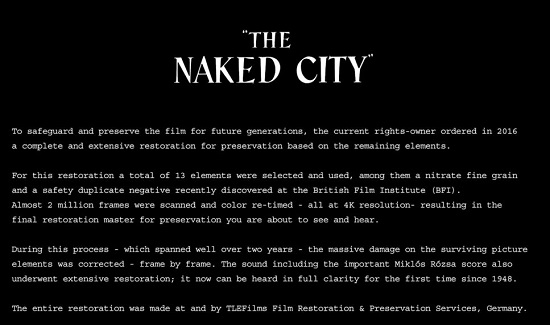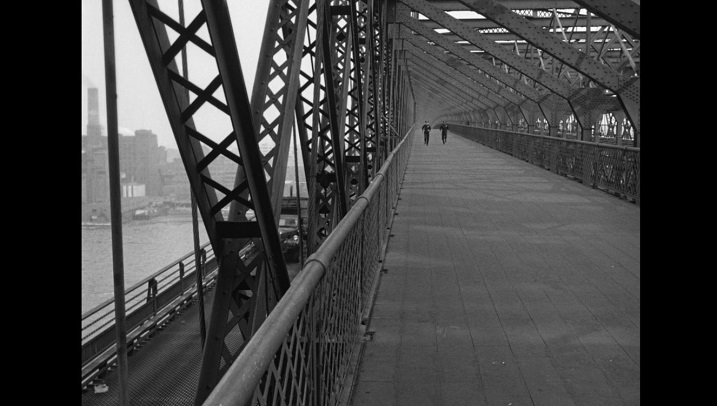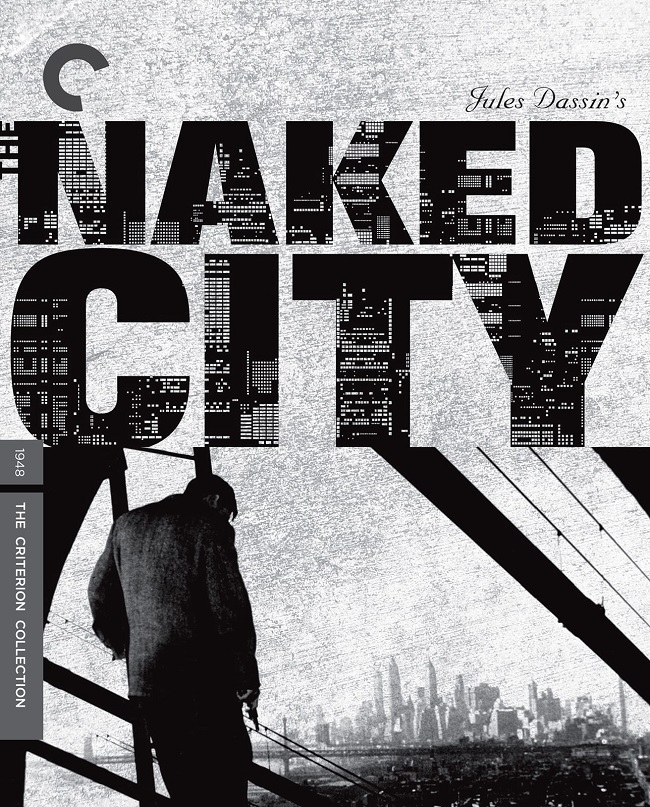The Naked City – The Criterion Collection (Blu-ray Review)
 On September 8th (Yeah, I’m behind), The Criterion Collection released two films from director Jules Dassin. In addition to the subject of this review, 1948’s The Naked City, they also put forth the film Dassin had done the year prior; Brute Force (1947). Aaron Neuwirth wonderfully covered that one for Why So Blu, so if you’re seeking a review on that title as well, you can find that by clicking HERE. While on the topic of previous reviews, I once reviewed a DVD set (“20 Star-Filled Episodes”) of the televisions series that spun off of The Naked City which shared the same time and you may find my words on that HERE. I first took in The Naked City as a part of a college course and found myself quite wow’d about everything this film had opened the door for and that we found quite par for the course by that time. You can find the film (And Brute Force) already available now, and as always, using the Amazon Associates link below is a kind way to help the site.
On September 8th (Yeah, I’m behind), The Criterion Collection released two films from director Jules Dassin. In addition to the subject of this review, 1948’s The Naked City, they also put forth the film Dassin had done the year prior; Brute Force (1947). Aaron Neuwirth wonderfully covered that one for Why So Blu, so if you’re seeking a review on that title as well, you can find that by clicking HERE. While on the topic of previous reviews, I once reviewed a DVD set (“20 Star-Filled Episodes”) of the televisions series that spun off of The Naked City which shared the same time and you may find my words on that HERE. I first took in The Naked City as a part of a college course and found myself quite wow’d about everything this film had opened the door for and that we found quite par for the course by that time. You can find the film (And Brute Force) already available now, and as always, using the Amazon Associates link below is a kind way to help the site.

Film 




“There are eight million stories in the Naked City,” as the narrator immortally states at the close of this breathtakingly vivid film—and this is one of them. Master noir craftsman Jules Dassin and newspaperman-cum-producer Mark Hellinger’s dazzling police procedural, The Naked City, was shot entirely on location in New York. Influenced as much by Italian neorealism as it is by American crime fiction, this double Academy Award winner remains a benchmark for naturalism in noir, living and breathing in the promises and perils of the Big Apple, from its lowest depths to its highest skyscrapers.
The Naked City still feels like such a revelation in the world of procedural detective dramas and its even more enlightening to see all the ground it was breaking throughout its run time. At times this feels like punk rock for its era, showcasing some real grit and horror of the world of crime and murder and at others looking like the film that genuinely felt like you were watching how the police work was done. And on the simplest of levels, its just a pretty damn good and enjoyable crime story/mystery to take in, take notes and watch unfold before your eyes.
“There are 8 million stories in the Naked City. This has been one of them.” So goes the point the film is trying to get across. That we are all just normal, bland people even though our stories can take interesting turns. The turn this film took set the stage for police/detective procedural dramas for years to come. The show would inspire its own television program, but would be the base for so many more. The film broke through in showcasing actually, patient police work step by step mixing the action in with the boring office stuff. That blend made for some compelling dramatics and a sense that you were following along on the case with the officers. Its something we take for granted today, but this was a breakthrough in its time.
Jules Dassin’s film told itself differently as well. While having a lot of the tropes and characteristics of the popular film noir genre, it has a very different way of telling it. There’s a fantasy element, a sexiness in the film noir films that’s been stripped here in exchange for some kind of “boring” realism. But with that comes some pretty brutal elements unseen. The scene of the murder in the opening has a sense of horror to it that feels really ugly and as if we shouldn’t be taking in what we are seeing. The way the goons handle and move the body feels graphic and spooky in a naturalistic way. Some of the characters feel dangerous, many of the situations have a sense of danger present due to the feeling that you’re watching something that feels like an actual account of what is going on instead of some glamorous tale of deceit in dreamy paradise. New York as the city is presented as a full, industrious town of normalcy. The film even closes with an ice cold line about its victim, “Her name, her face, her history was worth 5 cents a day for 6 days.”
Despite all of the genre crafting and revelatory details that come with The Naked City, it stands as a fine film itself. It has some nice dramatic turns intertwined with some cooky characters. The murder itself is not as simple as it appears once the getting beneath the surface and unlocking a bigger ordeal. There are also some thrilling chases and suspenseful sequences that hold up even to the this day. Like Dassin’s other films (Check out Rififi, its incredible), he’s made one that pretty much stands the test of time and works just as well today (Especially if take as a period piece) as it did back when it was released.

Video 




Encoding: MPEG-4 AVC
Resolution: 1080p
Aspect Ratio: 1.37:1
Layers: BD-50
Clarity/Detail: The restoration of The Naked City for this release is quite an extensive exercise and its documented in the book and in the form of a disclaimer that runs before the film plays (Showcased below). Once you’ve read about the difficulties and amount of sources that went into, the image becomes even more of an absolute triumph. The consistency is outstanding from scene to scene, with a crisp, detailed and well texture image. Its absolutely fresh in appearance with intriguing clarity. Without knowing, you’d have to had imagined this was an original 35mm print that had been well kept, yet its not quite that at all. We take for granted the work that goes into these, and its surprising that Criterion wasn’t beating its chest loudly about this as a promotional selling point. Instead they opted to go the humble brag route for those in the know.


Depth: The film’s image features some terrific distancing on display through every environment, inside or out. There’s a nice spacious freedom for characters to roam around the 1.37:1 frame. Camera movement is confident and smooth, capturing a nice “down the hallway” distancing in areas. Scale is quite well established, with the exteriors of New York feeling big and the finale giving the feeling of great heights. Movements are natural, cinematic and have no issues with motion distortions such as jitter or blur.
Black Levels: Blacks are rich and really flirt as much as they can with a natural level as one could hope for. The noir-like shadow and darkness is ideal for the era, up with the best of transfers. Patterns, textures and details found on darker surfaces and fabrics come through plenty discernible in most arenas. No crushing present.
Color Reproduction: N/A
Flesh Tones: Skin tones come with a consistent mixture of a white/gray palette that hold from the opening to closure of the film. Facial features obvious pop out more in close ups, but medium shots have an impressive amount of texture to them as well.
Noise/Artifacts: Clean

Audio 




Format(s): English 1.0 Mono LPCM
Subtitles: English SDH
Dynamics: The Naked City stays true to form with its original mono mix as depicting from the sole front center channel speaker. This is a nice mix, feeling free and loose with the separation of its effects, score and vocals. Its obvious that the low frequency sounds are not a factor here, but as a film of its era there lies an impressive nature in hearing how crisp and new this comes off feeling. The audio track is in quite good condition with the restoration as you can get a good sense of depth and layers in the blending of factors with the sound effects having an impressive natural quality to them.
Height: N/A
Low-Frequency Extension: N/A
Surround Sound Presentation: N/A
Dialogue Reproduction: Vocals are clear with a nice crisp feel as the words float along the slight vinyl-like hiss of the analog source as its base. The voice over narration and dialogue are on point with one another to a point where you might be convinced the narrator is an on screen character either out of sync or that someone with their back to the camera is speaking.

Extras 




The Naked City comes with your standard Criterion Collection essay and technical/production background booklet featuring the pieces “New York Plays Itself” by Luc Sante and “Notes on a Chase Sequence – The Naked City” by producer Mark Hellinger.
Audio Commentary
- Featuring screenwriter Malvin Wald (From 1996).
Dana Polan (HD, 28:11) – In this 2006 interview, New York University film studies professor Dana Polan, author of Power and Paranoia: History, Narrative and the American Cinema, 1940-1950, talks about The Naked City‘s groundbreaking social portrait. He discusses the idea of post war American and the struggle of being a replaceable cog in a system after “the last great adventure” and how The Naked City glamorizes, stands up for and tells them its okay to be bland, ordinary or an average Joe.
James Sanders (HD, 26:06) – Architect James Sanders is the author of Celluloid Skyline: New York and the Movies and cowriter of Ric Burns’s PBS documentary series New York. In this 2006 interview he discusses The Naked City‘s depiction of New York in the 1940s. He opens with discussing “actuality films” and that New York was the original place to shoot natural movies and then became a “mythic presence” artificially created in California by New York writers. After he talks of The Naked City, its use of New York and how it broke through in films shooting on location in city. Sanders is very thorough with his film and New York history, showcasing influences like the Italian films of the era being shot on the streets as well.
Jules Dassin At LACMA (HD, 40:45) – In 2004, Jules Dassin appeared at the Los Angeles County Museum of Art after a screening of his film Rififi. In this footage from the event, he discusses his career with Rialto Pictures’ Bruce Goldstein. Criterion warns of the poor quality of the source, which is kind to do, but this is perfectly fine and understandable. Thankfully they decided to put it on as this is a bit of a gem of a conversation as we have a fun, charming and insightful conversation with the film’s director present on the disc.
Still Gallery (HD, 5:42)

Summary 




The Naked City still manages to hold up and play quite well 72 years later and was a pivotal genre film of its time. The Criterion Collection has put together a marvel of a restoration here even without noting the extensive and exhaustive restoration work put forth the make this happen. Included are some equally outstanding interviews and discourse over the legacy and inner workings of the film to go with a nice vintage commentary track. For me, this was one of Criterion’s most exciting announcements this year, and it did not disappoint one bit. An easy recommend. Pick this one up.



















Best movie i have ever seen !